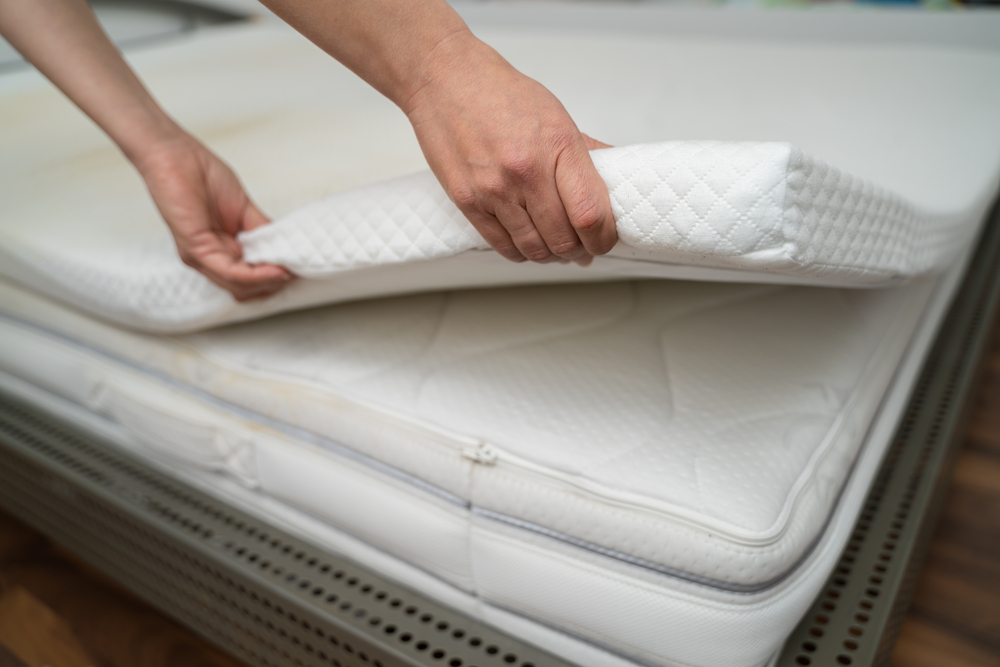Mattress Topper or New Mattress: Which One Should You Buy?

Let's be honest, a new quality mattress is expensive.
If you want a mattress that will last up to 10 years and still be comfortable, you'll likely spend at least $900.
With that said, many people will opt to purchase a mattress topper instead of buying a new mattress.
In some cases, this can be a great call that can save you a ton of money, but in other scenarios, doing this can cost you more money in the long run.
So, when it comes to revamping your sleep environment, should you buy a mattress topper or a new mattress? Buy a mattress topper if you have minimal needs such as softening a firm mattress. However, buy a new mattress if you have advanced needs, like when your current mattress has holes or when your physical health requires one.
Let’s dive into different but popular situations when a sleeper may be met with this conundrum.
Need Help Sleeping Better? Request our FREE Sleep Hygiene Guide.
Mattress is Overly Firm
If you bought a new mattress only to find it firmer than what you expected, you could be stuck with an uncomfortable mattress for years. Remember, a firm mattress may also cause back pain for sleepers below 150 lbs. How do you solve this situation?
No, don’t buy another new mattress. If your mattress brand allows exchanges within the night trial, then switch with a softer mattress. However, if you’re past the night trial, you can purchase a soft mattress topper to relieve the firm feel of the mattress.
Similarly, if you buy a mattress and it turns out to be slightly softer than what you need, purchase a firm mattress topper to add some support to your bed.
I Want A Bed Upgrade (But I Don't Want To Pay Much)
If you're looking to add an extra layer of comfort to your existing mattress but aren't prepared to shell out $800-$2000 for a new, premium mattress, buying a comfy mattress topper can be appealing.
As long as your current mattress isn't sagging and isn't more than 5 years old, investing in top-quality mattress toppers can be a great way to bring a bit of luxury back to your sleep.
In the table below we shall compare the prices of one of our favorite toppers the Molecule CopperWELL™ which offers amazing cooling and breathability. We’ll also look at the prices of a new mattress, the Molecule 2 AirTEC™ which similarly offers remarkable cooling and contains antimicrobial features.
As you can see, a quality new mattress can cost you an average of $1300, while a quality topper can cost you below $300, which is significantly lower. This makes a mattress topper ideal for any budget shopper with minimal mattress needs.
Mattress Is Older Than 7 Years
One of the tell-tale signs of an old mattress is indentations and sagging. This often happens when you have a mattress you can't rotate, so you sleep in the same spot for a long time.
If your mattress is sagging, a mattress topper isn't going to help. In fact, purchasing a mattress topper will cost you more harm than good.
Once you add the mattress topper, you'll realize it hasn't solved your problems and will be at least $200 in the hole. This money is better spent on investing in a new mattress.
Mattress Is Too Hot
If you're a hot sleeper and find yourself waking up in the middle of the night sweating, your mattress’ cooling feature isn’t as efficient.
Buying a mattress topper with cooling properties can help maintain comfortable sleep temperatures. However, if you're using a mattress that tends to trap heat, such as down and memory foam models, your topper might have quite a hard time keeping you cool.
Some people are strict hot sleepers and need top-quality sleep products with breathable materials and cooling technology to help them sleep comfortably. If this sounds like you, investing in a cooling mattress is the best thing you can do for yourself.
Mattress Pad Vs. Mattress Topper
Generally, choosing between a mattress pad and a mattress topper comes down to your personal needs and preferences.
For instance, mattress pads will suffice if you simply want to add a little comfort to your mattress while protecting it from dirt, stains, and accidental spills. It won't significantly change your bed's firmness level and feel, but it can soften or reinforce the surface depending on your preferred design and material.
On the other hand, mattress toppers are ideal for sleepers who want to substantially change the feel of their mattress. And since they're about 3 inches thicker than mattress pads, they deliver a more notable transformation in body support and overall comfort by providing extra cushioning and pressure relief.
Mattress Topper vs New Mattress Comparison Table
Here are 6 common instances when you’ll have to choose between buying a new mattress or a mattress topper. We'll use (✓) for when the product is recommended and (X) for when the item is not necessary.
Scenario | New Mattress | Mattress Topper |
|---|---|---|
Mattress feels too firm | ✓ | X |
You want to upgrade without spending much | X | ✓ |
Mattress is older than 7 years | ✓ | X |
Mattress feels a bit hot | X | ✓ |
Mattress has significant sagging | ✓ | X |
For advanced mattress comfort | X | ✓ |
Wrapping It Up
Whether or not a mattress topper or a brand new mattress is best for you depends entirely on your unique sleep needs, financial considerations, and the condition of your existing mattress.
If your current mattress is still in good shape but you'd like to change its feel or make it cooler, the right mattress toppers can enhance comfort and offer a more cost-effective solution for extending your mattress life. However, if your aging mattress is torn, stained, or has body indentations, purchasing a new one could be the most effective long-term solution.
Courtney is the reason The Sleep Shop exists. She’s a Seattle native with a passion for healthy sleep. She graduated from Seattle Pacific University with a major in marketing. She started The Sleep Shop to help friends and family choose a good mattress, and helped grow the site to what it is today. She does most of the product testing and reviews.
Learn More About Courtney

My mattress hasn’t been very comfortable lately, and I’m not sure what to do about it. It makes sense that getting a brand new mattress might be a good choice! That seems like a good way to completely change up how my bed feels.
I have an expensive adjustable bed and mattress. The mattress is too firm I can’t seem to get comfortable in any position. I toss and turn all night. I have had four back surgeries I feel exhausted. I saw the reviews for a high end wool mattress topper all the reviews raved about the decision to invest, &500 + dollars for the topper OR $2,399 for a fabulous Sterns & Foster mattress? I am so tired
Get a new mattress! Toppers are expensive and don’t last long.
That’s a very well put together article, toppers are actually underestimated
I’ve been sleeping on a Serra Vantage firm hybrid for 8years. I weigh 118 lbs so the mattress is like new, no sagging and very firm. I’ve always had a protective cover on it. I’ve had lumbar back problems for years and just had surgery.
Just bought a latex hybrid online for about $1500 and a platform bed frame for $250, as recommended. Sleeping on it for about 6 weeks now and not finding it helps. Actually doesn’t seem to keep my spine aligned as promised.
Thinking about returning it and getting a 2 inch latex topper for my old mattress instead. Thoughts? No one’s doing Spine replacements.
Hi Fred. Sorry for your predicaments. Normally mattresses work for some people but not everyone. Therefore you should browse for a solution that fits you and read guidelines from several mattress testers like us to get an idea of what would work. Depending on the topper you get, it may just be the solution (and a cheaper one) to spinal alignment; but first make sure the pillow you use and your sleeping style are not the issue. Browse around our blog for some sleeping tips for pain and after surgery. All the best and full recovery!